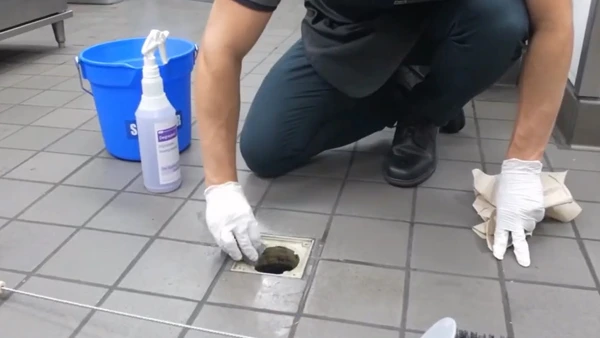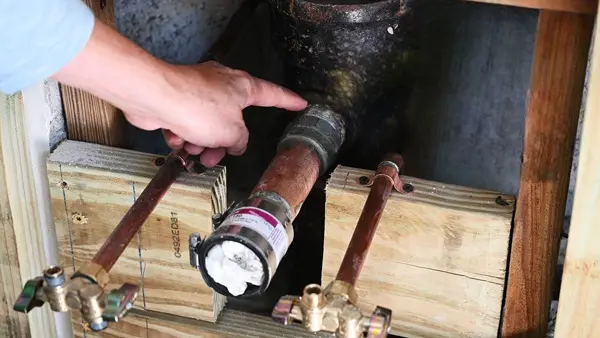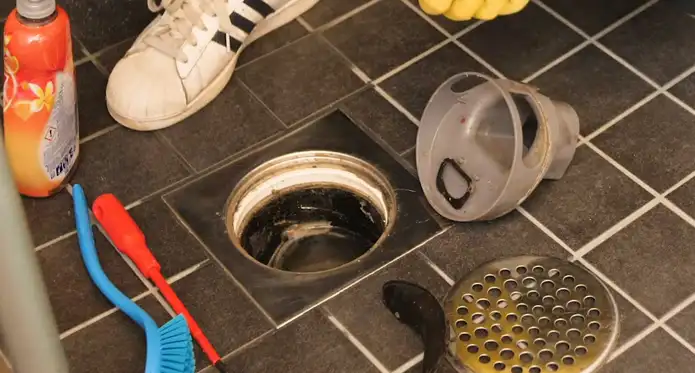Last Updated on July 31, 2023
Without regular cleaning, the cast iron floor drain thread can become clogged over time. As grease, food particles, and other debris accumulate, the drain may eventually become clogged & rusty, resulting in water backing up and flooding the area.
Aside from that, the buildup of dirt and bacteria can create unhealthy conditions that attract pests, such as rodents and insects. So you need to clean the threads in your cast iron floor drain to prevent these problems. But how to clean threads in the cast iron floor drain?
The drain cover and drain plug must be removed before you can begin cleaning the threads. Afterward, you can access the area that needs to be washed. You can use a wire brush or a power washer to clean the threads. Please continue reading to learn how to clean cast iron floor drain threads.
How to Clean Threads in Cast Iron Floor Drain in Your Home?

Before you can work on cleaning the threads of your cast iron flooring drain, make sure you take a few basic safety precautions:
- Be sure to wear gloves to protect your hands from the harsh chemicals you might be using.
- Put on a dust mask to avoid breathing in any harmful fumes.
- Ventilate the area well by opening windows or using a fan.
With these safety measures, you’re ready to start the cleaning process. Now follow these steps:
Step 01. Remove Debris or Foreign Objects
Several methods can clean foreign objects from your cast iron floor drain. But you can use a putty knife, an old toothbrush, or a wire brush to loosen and gently remove anything stuck. Simply insert the wire brush into the drain and twist it around to loosen any dirt, hair, or other debris accumulated in the threads.
Another way to remove foreign objects is with a plumber’s snake. To use a snake, insert it into the drain and turn the handle to spin the coil inside the drain. This will loosen any debris that’s caught in the threads. Once you have removed the object, you can clean the threads.

Step 02. Rinse the Thread With Hot Water
If you have stuck food particles on a cast iron floor drain around the house, rinse the thread thoroughly with hot water. This will lose any stubborn particles and make it easier to clean the threads.
To do this, simply pour a pot of boiling water down the drain. Let it sit for a few minutes before using any cleaning solution to clean the threads. If food particles or grease remain on the thread, they can attract ants and other insects. Also, the thread can become corroded over time if it’s not cleaned correctly.
Step 03. Apply the Cleaner to the Thread
When cleaning a cast iron floor drain, remember to use a brush with soft bristles so as not to damage the finish on the drain. Apply the cleaner to the brush and then scrub the threads vigorously. Rinse all the cleaner and debris before allowing any water to enter the drain.
One of the most common cleaners used for this purpose is white vinegar. Simply apply the vinegar to a brush and gently scrub the threads. The vinegar’s acidity will help break down any build-up on the drain, making it easier to flush away. Also, vinegar is a natural disinfectant, which will help prevent the growth of fungi.
Another option is to use a cleaner specifically designed for cleaning drains (such as CLR, Drano, and Liquid Plumr). These cleaners typically contain harsh chemicals that can quickly eliminate any buildup in the drain.
Applying a cleaner to threads in a cast iron floor drain is essential for many reasons:
- It helps to loosen any stubborn rust or particles clinging to the threads. This makes it easier to remove the drain cover and allows for deeper cleaning.
- Cleaners help to kill any bacteria or other microorganisms that may be present on the surface of the drain. This is especially true in homes with small children or pets, as these groups are more susceptible to illness.
- Using a cleaner on drain threads helps to prevent rusting and corrosion. This is particularly important in areas with high humidity levels or where salt is used frequently (such as in coastal regions).
Step 04. Rinse the Drain Thread
Use a hand-held shower head to rinse the drain thread. Attach the shower head to the end of a garden hose and turn on the water. Aim the shower head directly at the threads on the drain and let the water run for several minutes.
You may need to move the hose around to reach all the threads. Once you have rinsed all the threads, turn off the water and inspect them to ensure they are clear of buildup. If they are not, repeat the process until they are clean.
Step 05. Reassemble the Drain Thread
After you have cleaned the threads on the drain, you can reassemble it. First, put on a rubber glove to protect your hands. Now, take the drain cover and align it with the threads on the drain. Slowly screw the cover onto the drain, careful not to cross-thread it.
Once the cover is tight, remove the glove and flush the drain with warm water to remove any cleaner residue from the cover. You should now have a clean, functional cast iron floor drain.
Is it Possible to Clean the Cast Iron Floor Drain Threads?

Many homeowners have a cast iron floor drain in their laundry room, basement, or garage. Over time, the threads on the drain can become clogged with dirt particles and rust, making it difficult to connect a hose or other drain cleaning tool.
While cleaning the threads with a wire brush or other tool is possible, this can be a difficult and time-consuming task.
You may wonder if it’s possible to clean the threads on your cast iron floor without disassembling the drain. The good news is that there are some ways to clean the threads without tearing the drain apart.
What are the Reasons for Thread Blockage in Cast Iron Floor Drains?

A clogged cast iron floor drain can be a significant annoyance. Not only does it cause water to back up in the sink or tub, but it can lead to unpleasant odors and messy cleanup.
There are numerous reasons for clogging a cast iron floor, including:
- Cast iron drains can get pitted and corroded in wet places, such as laundry rooms, basements, or the kitchen sink.
- The cast iron drains could also accumulate sediment, grease, and hair built up over time.
- Tree roots may occasionally grow into drains, causing them to become blocked.
When the smooth surface of the drain can become pitted and corroded, it is more difficult for water to drain correctly. Due to this, you should clean cast iron floor drains regularly to prevent them from becoming blocked.
How to Identify Rusty Threads in Cast Iron Floor Drain?

Although cast iron is a durable material that can last for many years, it is not immune to corrosion. One sign that a cast iron drain pipe thread is starting to rust is the presence of corrosion. These threads can be most easily seen at the point where the drain body meets the floor.
Rusty threads can cause the drain to leak, and if left unchecked, this will eventually cause the threads to break, making it difficult or even impossible to remove the drain for cleaning or repair. It is possible to tell if a cast iron floor or shower drain has rusty threads:
- Take a look at the outside of the drain. This is a sure sign of rust if you see any red or brown stains.
- Check the inside of the drain for any flakes or powdery residue. This is another telling sign of rusting threads.
- If you see any cracks or chips in the drain thread, this is also an indication that the threads are beginning to rust.
Rust can spread quickly and cause severe damage to your cast iron basement floor drain. Thus, if you notice these signs, you must act immediately. Otherwise, the cast iron drain will eventually need to be replaced.
Is Hydro Jetting Cleaning Safe for Old Cast Iron Pipes Threads?
Hydro jetting is a safe and effective pipe cleaning process that uses high-pressure water to remove blockages and build-up from pipes. This method can be used on various pipe materials, including cast iron.
The hydro jetting process uses a specially designed nozzle that ejects a powerful stream of water. This stream of water is strong enough to break through even the toughest clogs without causing damage to the pipe material.
Also, the jetted water’s high pressure helps clean the pipes’ inside, removing any residue that has built up over time. Hence, hydro jetting is incredibly effective in cleaning cast iron pipes and threads without damaging the pipes or causing any harm to your plumbing system.
Will Vinegar Hurt Cast Iron Pipes Threads When Cleaning?
When cleaning your home, you want to use vinegar to do the job without damaging your surfaces. Vinegar is often touted as a natural cleaning solution, but take care when using it on cast iron.
The acid in vinegar can break down the protective coating on cast iron, leaving it susceptible to rust and corrosion. If you use vinegar, dilute it with water and rinse the area thoroughly afterward.
Can You Use Steel Wool on Cast Iron Pipe Threads for Cleaning?

One popular method is to use steel wool to clean cast iron pipe threads. This can be effective in removing rust and debris from the threads. But one common question is whether it is safe to clean cast iron pipe threads with steel wool.
The answer depends on the condition of the cast iron. If the cast iron is heavily rusted, steel wool may be the best way to remove the rust. But, if the cast iron is only lightly rusted or dirty, it is best not to use steel wool as it can cause scratches. In these cases, it is recommended to use a cleaner designed for cast iron.
How to keep Cast Iron Floor Drain Threads Clean in the Future?
Cast iron floor drains are susceptible to build-up over time, eventually clogging. If not adequately maintained, drain threads become corroded and challenging to clean. To prevent this, ensure you regularly clean the threads with a brush or other cleaning tool.
Also, it is helpful to apply a coat of Vaseline or another type of lubricant to the threads before use. This will help to keep the threads from becoming stuck together.
You should be careful when using harsh chemicals or cleaners on the drain. These can damage the finish and make it more challenging to clean subsequently.

